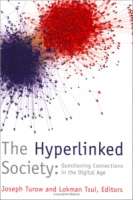 A while ago I posted a partial review of The Hyperlinked Society: Questioning Connections in the Digital Age. That review has since been accepted and will appear in a forthcoming volume of the academic journal e-Learning and Digital Media.
A while ago I posted a partial review of The Hyperlinked Society: Questioning Connections in the Digital Age. That review has since been accepted and will appear in a forthcoming volume of the academic journal e-Learning and Digital Media.
I realised this week that I never posted the completed review. So here it is, for what it’s worth, in full! 😀
The Hyperlinked Society: Questioning Connections in the Digital Age
Joseph Turow and Lokman Tsui, Editors (2008)
Ann Arbor: University of Michigan Press
ISBN 0-472-05043-5 (pbk)
319 Pages.
Reviewer: Doug Belshaw, Durham University
In the introduction to The Hyperlinked Society, editor Joseph Turow explains how the book became a follow-up to a 2006 conference that ‘came together to address the social implications of instant digital linking’. ‘We did not intend to solve any particular problem at the meeting,’ he writes. ‘Instead, the goal was to shed light on a remarkable social phenomenon that people in business and the academy usually take for granted.’ The stated aim of the resulting book? ‘[N]ot to drill deeply into particular research projects [but], rather, to write expansively, provocatively – even controversially – about the extent to which and ways in which hyperlinks are changing our worlds and why.’ The book, therefore, is published explicitly as a platform upon which others ‘will launch their own research projects and policy analyses.’ (p.5)
Given this stated aim, it is easier to forgive The Hyperlinked Society‘s unconventional structure and somewhat eclectic nature. There are three main sections to the book. The first, ‘Hyperlinks and the Organization of Attention’ is almost entirely descriptive, ostensibly to set the scene for the rest of the book. The second ‘Hyperlinks and the Business of Media’ appears incongruous in an academic book; the essays and articles it contains feature few references and assertions abound. The final section is the most rewarding for researchers and academics in the field of new literacies and internet culture. It features an abundance of analysis – everything from the moral nature of hyperlinks to what constitutes the ‘online public sphere’. This final section is worth the price of admission alone.
Puzzlingly, given the editor’s proud statement in the introduction that over 200 countries were represented at the conference that led to the book’s existence, the examples given are almost entirely taken from the USA. Moreover, the American political situation and how it reflects, and is reflected by, internet culture is a dominant theme. Indeed there is more than one reference to ‘our country’ and what ‘we’ need to do. This does not sit comfortably at times, making this (English) reviewer feel like an outsider.
But there is much to like and admire in The Hyperlinked Society even if, at times, the authors try and relate anything and everything to the concept of the hyperlink. The editors have discovered and successfully begun to fill a niche: that space between popular internet culture books such as Clay Shirky’s Here Comes Everybody and more traditional academic articles. The Hyperlinked Society successfully combines elements of both, especially in the third section and in particular Adamic’s The Social Hyperlink. This essay continues the collection’s dominant theme of political blogging, showing empirically that the ‘blogosphere’ is divided with hyperlinks mirroring political affiliations. Coupled with this, however, is a corrective to the possible conclusion that hyperlinks cause this ‘echo-chamber’ effect. An analysis of online communities in the USA, Kuwait and the UAE demonstrate the powerfully complex cultural and contextual factors at work. The reader is left fascinated, interested, and wanting more – especially given the ‘Do bloggers kill kittens?’ story with which Adamic ends the article. This, of course, fits hand-in-glove with the editor’s desire for others to use the collection as a starting point for their own research.
A second dominant theme in The Hyperlinked Society is whether hyperlinks constitute an inherently a ‘good’ or a ‘bad’ thing for society. Most deal with this in a cursory way, but Weinberger’s The Morality of Links confronts the issue head-on. In perhaps the most valuable and reflective essay in the collection, Weinberger analyses his personal belief that ‘Links are good’. His wide-ranging and knowledgeable philosophical treatment of the problem takes fully three pages of background, covering everything from a critique of Essentialism to the value of a funnel. Weinberger concludes that there are two reasons why ‘Links are good’. First, the Web is a huge potentiality – but not in the same way ‘a stick could potentially be used to prop up a car hood’ (p.189). Instead, ‘the potential is the sum of the relationships embodied in links’ which makes the Web ‘a potential that we’re actively creating and expanding’ (p.189). The second reason we’re better off with links, states Weinberger, is because ‘every time we click on a link, we take a step away from the selfish solipsism that characterizes our age – or, to be more exact, that characterizes how we talk about our age’ (p.189-90). The world, says Weinberger (quoting Ted Nelson) has never been so ‘intertwingled’.
The third and final dominant vein running through The Hyperlinked Society is the emancipatory nature of hyperlinks. Whilst several authors raise privacy concerns and implications , the general consensus is that through ‘mashups’, ‘countermapping’ and other online grassroots activities, traditional power structures are beginning to be challenged. Halavais, for instance, in The Hyperlink as Organizing Principle explains how the changing way hyperlinks are used represents ‘a kind of collective unconscious’ that represents ‘deep social and cultural structures’ (p.39). Halavais also points out, with some apparent glee, that researchers can passively track social relationships and connections through the aggregation of links – thus alleviating the ‘Hawthorne effect’ and bias inherent in self-reporting.
Finkelstein, in Google, Links and Popularity versus Authority highlights two important instances where technical issues relating to hyperlinks threatened to undermine their potential for emancipation and democracy. The first is what he deems ‘the commodificiation of social relations’. This is a result of ‘blurring the lines between business and friendship’ (p.115) that occurs online. A second, related, problem is that of search engine algorithms being based on inbound links. Google’s PageRank algorithm, for example, works a ‘weighted combination’ of factors centering around how popular the website is with other websites. Herein, of course, lies a problem. If you want to talk about the dangers of a racist hate site, making parents and teachers aware of the URL , linking to the site would be counter-productive. It would constitute an inbound link – and therefore improve the racist hate website’s Google PageRank. As a result, the ‘nofollow’ tag was invented to allow links in such cases without the attendant positive conferral of status (or ‘Google juice’ as it is commonly termed). This is an example of what The Hyperlinked Society does well as a collection, dealing with both the social and technical aspects of problems caused by Web-mediated communication.
The Hyperlinked Society is not an overly-edited collection. There are places where the same stories are told, the same studies cited, and similar ground covered. But given the and/and/and nature of hyperlinks and the Web, this is highly appropriate. Instead of fitting rigorously into a pre-determined order, the authors are free to explore their own interests in a way that suits them. Such a structure and approach works well, and serves to reinforce the themes outlined above: the case of political blogging, the nature of hyperlinks, and their emancipatory potential.
However, as a researcher into new literacies and 21st-century education practices, it was disappointing to see terms such as ‘link-literacy’, ‘savvy’ and ‘competence’ used uncritically. There is a wealth of research in this area towards which the individual authors or, at the very least, the editor could have directed the reader. Although Lankshear and Knobel’s Digital Literacies: Concepts, Policies and Practices was published in the same year as The Hyperlinked Society, their earlier volume New Literacies: Everyday Practices and Classroom Learning (2006) was available as a guide to the field.
Overall, The Hyperlinked Society is satisfying and informative when read in its totality, but also serves as an excellent reference point, with useful overviews to each section provided by the editors. It would be of most use to those running postgraduate courses exploring Web-related issues as it covers such a wide range of issues. The final section in particular is an object lesson on how to explore the wider implications of a very particular technology.
References
- Lankshear, C. & Knobel, M. (2006) New Literacies: Everyday Practices and Classroom Learning. Open University Press
- Lankshear, C. & Knobel, M. (2008) Digital Literacies: Concepts, Policies and Practices. Peter Lang Publishing
- Shirky, C. (2008) Here Comes Everybody: The Power of Organizing Without Organizations. New York: Penguin Press



 In the 1930s, William Empson came up with seven types of ambiguity. He applied them to poetry and literary criticism, but I believe they can be more applied more widely. Roughly, they are:
In the 1930s, William Empson came up with seven types of ambiguity. He applied them to poetry and literary criticism, but I believe they can be more applied more widely. Roughly, they are: